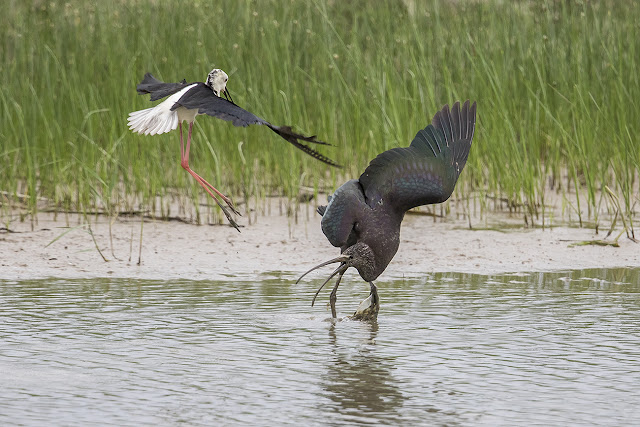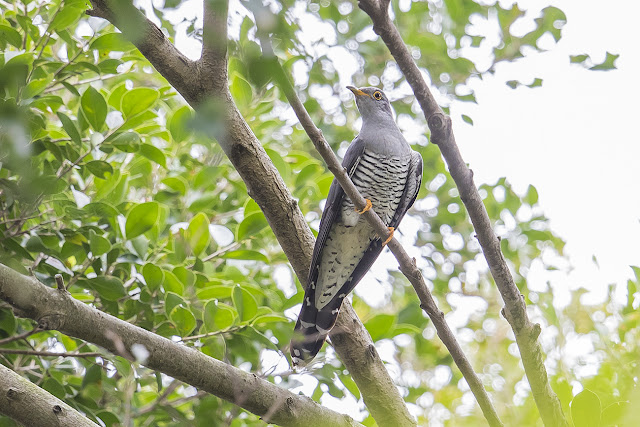Come late May and early June, rarities are hard to come by, Mai Po had been one of the few places where birding can still be relatively productive. I finally caught up with the long staying Glossy Ibis at scrape 16/17, it showed exceptionally well and occasionally coming in very close to hide 3. This was only the 3rd record for Hong Kong, with last year's duo staying well over a month, this individual is looking to break their record. There was a clear influx of Glossy Ibis to Taiwan this year, with reports of a pair even attempting to breed, whether this will happen in Hong Kong in the future remains to be seen.
Glossy Ibis
Glossy Ibis - quite the poser...
The breeding Black-winged Stilts on scrape 16/17 are proving to be menace for most birds, they are fierce defenders and will chase off almost any birds that come near their territory, the Glossy Ibis was happily feeding nearby but occasionally does get 'scolded' by the stilts, which often result in the Ibis flying off to another corner of the scrape.
Black-winged Stilt - at nest with eggs
Black-winged Stilts chasing off the Glossy Ibis
Another prominent species at the same scrape were a dozen of Greater Painted Snipes, they usually hide in the tall grass opposite the hide, but occasionally will run out of their cover. Most seems to have formed pairs, although Greater Painted Snipes are polyandrous, where female's sole responsibility is to lay eggs, while the male do all the hard work in making the nest and raising the chicks, so we are likely to see males with chicks in the next month or so.
Greater Painted Snipe - one of the many pairs at scrape
Greater Painted Snipe - female
Greater Painted Snipe - male
With so many pairs of Greater Painted Snipes, the males and females often gets into fights of their own, both sexes can get aggressive and chase away their rivals, here is a female raising its wings to scare off another female.
Greater Painted Snipe - female in threatening display and inflight
Other recent rarities at Mai Po includes a female Cotton Pygmy-Goose, the lonesome bird was found feeding on algae along the border fence, it was very far away, so I only took a few record shots of this rarity. We do occasionally get this species coming through Hong Kong, the last Cotton Pygmy-Goose I saw was at Mai Po back in 2015.
Cotton Pygmy-Goose - lonesome female
The Common Cuckoo stayed on a little longer, I went back again for some better photos, it behaved much better after a few days. Also present was a Lesser Cuckoo of which I heard only. There was also a report of a Jacobin Cuckoo at Mai Po a few days back, but didn't receive the news until the next day, no one were able to relocate the bird, this will be a first for Hong Kong if accepted, and a species that have been on the possible list of birds for Hong Kong.
Common Cuckoo - good to get better photos the second time
There have been considerably more rain the last week or so, good news for local wildlife! The other night we went for a night walk in Sai Kung which produced two Greater Green Snakes. Other reptiles and amphibian species that are active of late includes many Chinese Geckos, Paddy Frogs, Gunther's Frogs, Asian Painted Frogs and Asian Common Toads.
Greater Green Snake - Ptyas major
Chinese Gecko - Gekko chinensis
Paddy Frog - Fejervarya multistriata
Gunther's Frog - Sylvirana guentheri
Asian Painted Frog - Kaloula pulchra
Asian Common Toad - Duttaphrynus melanostictus
Acisoma panorpoides
Brachydiplax flavovittata
Brachythemis contaminata
Idionyx victor
Prodasineura autumnalis
Zyxomma petiolatum
Polycanthagyna erythromelas





























